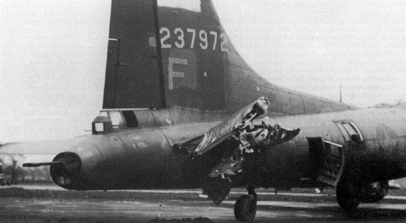We've all seen the war films: Massive wingtip-to-wingtip formations of four-engined heavy bombers, bombing Berlin and dismantling Dresden, tons upon tons of high-explosive raining from the sky. The bomber that made this possible was the B-17, nicknamed the "Flying Fortress" due to its impressive defensive armament and massive bombload.
 |
| A B-17 on a combat mission. Note the German Me-163 rocket-powered interceptor in the background. |
But the B-17 came very close to not reaching production. The design originated in a US Army Air Force (USAAF) proposal in 1934 for a mulitengine bomber to replace the ageing B-10. Three proposals were submitted: the Martin Model 146, the Douglas DB-1 (B-18), and the Boeing B-17. The USAAF arraged a 'fly-off' between the three at Wright Field in Ohio.
 |
| Douglas B-18 |
 |
| Martin Model 146 |
.jpg/1024px-Boeing_XB-17_(Model_299).jpg) |
| Boeing B-17 |
The B-17 was smashing the competition in terms of bomb-load, defensive armament, speed, survivability, engine-out performance, etc. But on one of the test flights, the flight crew forgot to disengage the 'gust locks' that locked control surfaces while the aircraft was parked. The XB-17 took off, entered a steep climb, stalled, and fell to the ground. The aircraft was a complete wreck. How much, you ask? This much:
 |
| I sawed this bomber in half! And it just needs a bit of flex tape to be as good as new! |
Due to it being broken in multiple places, the XB-17 couldn't finish the competition, and so was disqualified. Orders for 65 trial B-17s were canceled, and 133 B-18s were ordered instead. But the Air Corps liked the B-17. They liked it so much that they found a legal loophole and managed to order 13 of the big bombers. The Air Corps also found a way to prevent another 'gust lock' crash: Use a pre-flight checklist. As the B-17 proved its worth, official resistance to the new bomber faded away, and ten more were ordered. Soon afterwards, the USAAF decided that they
really needed heavy bombers, so they ordered 512. Only 200 were delivered before Pearl Harbor, however. The first mission against the Axis was flown by Royal Air Force (RAF) B-17s in 1941. The use of the big bombers skyrocketed, and by the end of the war, 32 overseas groups operated the '17, with 4574 USAAF B-17s worldwide. Many models and improvements of the basic design were pushed out by Boeing as the war progressed. One of the first improvements was replacing the ventral gondola 'bathtub' gun position with a power-operated ball turret.
 |
| The 'bathtub' gondola on an early-model RAF B-17 |
 |
| A later USAAF B-17 variant with a ball turret replacing the 'bathtub' |
The bomber was then up-gunned, replacing the puny .30 cal machine guns with 'Merican .50cal Browning heavy machine guns. Various models had slightly different statistics, but the B-17G, the best-armed variant, carried no less than thirteen of the deadly guns in 8 positions: 2 in the chin turret, 2 on the nose 'cheeks,' 2 waist guns, 2 in the dorsal turret, 2 in the ball turret, two in the tail potion, and one in the navigator's compartment.
 |
| B-17G cutaway |
With this armament setup and flying in huge 'combat box' formations for mutual defense, the '17 earned the nickname 'Flying Porcupine' from Luftwaffe interceptor pilots. The B-17 crews did like this armament, but the mortality rate was still extremely high. Crews serving for a full deployment had a 45% chance of being shot down, and 8% chance of becoming Prisoners of War. Even with these low statistics, the B-17 proved to be extremely good at soaking up battle damage, some returning to base on fire, missing pits of fuselage, missing most of the tail section, or even missing most of the outer wing!
 |
| 'All American' nearly got her tail cut off from a ramming attack |
 |
This '17 got her starboard stabilizer shot off
|
 |
| This poor 'fort' got her nose shredded by flak. |
All in all, the Flying Fortress was one of the better bombers of the war. Tough, well-armed, and with a large bomb-load, it was and still is an iconic aircraft.
 |
| A literal flying fortress |


.jpg/1024px-Boeing_XB-17_(Model_299).jpg)






2 comments:
I can really see your interests through this blog! I find it really funny how the B-17 wasn't destroyed by the enemies but rather the flight crew forgot to disengage the 'gust locks' and the plane rolled off the hill.
What a complete, comprehensive blog! It's clear you're very passionate about planes and thorough in your work. It seems amazing that a "pre-flight checklist" didn't exist until the crash of the B-17, because it seems so intuitive nowadays. This whole thing is practically an essay, definitely deserving of an A!
Post a Comment